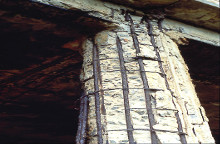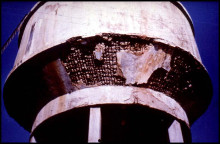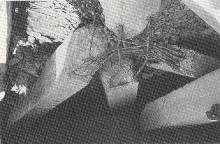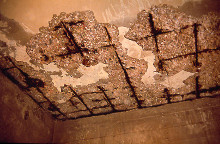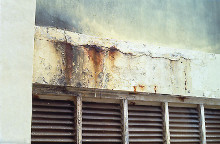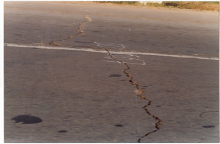Deterioration of Structures
A. Introduction:
In many cities, we come across old buildings needing major repairs or in a dilapidated condition and unfit for occupation. However, if a building has given about 25 to 30 years of service without much maintenance or repair, then it is reasonable to expect that it would need some repairs. Structures are also damaged due to Earthquake / wind effect. One of the causes for this is weathering and ageing effect or inadequate maintenance and care. However, many poorly designed and / or constructed buildings are also found to be in a very bad structural and general health condition needing major structural repairs. This premature deterioration is largely due to poor quality of construction or inappropriate design and / or neglect of timely repairs.
The performances of concrete structures depend not only on the external abuse, but also on the quality of concrete, ambient conditions and method of concreting and curing etc. Therefore, it is necessary to understand why the concrete fails or cracks. There can be many reasons why the concrete deteriorate, which needs to be understood. The incidence of cracks can be minimized by improving concrete mix, better laying practice, and appropriate weather condition and properly managed curing. Thus some of the main reasons of deterioration of structures are:
- Improper Design of Structure
- Poor Construction Quality of Concrete
- Improper construction / concreting practice.
- Change of loading pattern or non-conventional Loading on structure
- Extreme weather conditions causing weathering of concrete.
- Water Leakage leading to corrosion of concrete and Reinforcement
- Regular wear and tear during the service life, etc.
B. Expected Service Life Of Structures:
There is very little literature available on the subject of expected service life of structures. BIS also does not define the design lifespan. The lifespan of RCC generally is taken as 100 years. However, there are some times pre-defined specifications for projects and expected conventions about design life span. Some of these expectations and prevalent conventions are given below:
- Monumental Structure like temple, mosque or church etc to last for 500 to 1000 years.
- Steel Bridges, Steel Building or similar structure for about 100 to 150 years.
- Concrete Bridges or High-rise Building etc or stone bridge etc for about 100 years
- A house or general Building etc for about 60 to 80 years.
- Highways: Concrete pavements for about 30-35 years and bituminous pavements for about 8-10 years.
C. Common failure modes of concrete structures:
Let us understand the probable causes for poor performance or faster deterioration of buildings, so that precautionary measures, either during construction or for repairs, can be taken by owners. Some common types of distresses encountered in concrete are Cracks, potholes and erosion of the top layer of concrete, rusting of reinforcement, splitting etc. The details of some these aspects are given here:
- Poor Concreting in beam and column and less cover, missing ties
- Water tank less cover in sofit of slab and week concrete
- Failure of Column Beam Joint due to congested reinforcement and no detailing of reinforcement at junction
- Initially rested Reinforcement bars and less cover in sofit of slabs
- Poor quality of concrete and in grace of moisture leading to corrosion and Bars in Corrosion Environment Led to Spalling and Delamination
- Cracks in concrete pavement because of Alkali-aggregate reaction
a. corrosion and Cracking of Structures:
Cracking is the most common phenomenon in concrete structures. These may be hairline cracks or wider cracks. Cracking of concrete may occur because of several reasons. These may include temperature stresses, excess loading on structure, weathering of concrete, conduit pipe line insertion etc. Cracking of concrete section cannot be prevented, but the size and location of the cracks can be limited and controlled by reinforcement, placement and the better concreting & curing methodology. Cracking sometimes times also results due to inadequate quantity of rebar, or rebars spacing. The concrete then cracks either under excess loading or due to internal effects such as early thermal shrinkage when it cures. The concrete may also develop cracks due to plastic Shrinkage cracks, or temperature cracks after concreting.
Reinforced concrete can also fail due to inadequate strength, leading to mechanical failure, or due to a reduction in its durability. Corrosion and freeze/thaw cycles may damage poorly designed or constructed reinforced concrete. When rebar corrodes, the oxidation product (rust) expand the concrete and tends to cracking of concrete and un-bonding the rebar from the concrete. A pictures showing the distress of structures are shown in figure 1 and onwards and discussed accordingly.
b. Poor workmanship: Untrained Manpower & Bed Quality of Construction:
The Concrete structure failing at an early life span or earlier because of poor construction means no proper concrete quality is used or had bad workmanship etc. Therefore, the causes of premature deterioration in relatively new buildings are different as compared to those for old buildings. Poor concrete and / or bad rebar detailing should always be checked in column beam junction as shown in figure 2.
Sub-standard workmanship during construction also affects the quality of construction. In concrete this can be in the form of honey combing, improper compaction of concrete, inadequate cover to reinforcement etc. Some of these deficiencies may become evident only after the full loading of structure or after 5 to 10 years.
c. Excessive water cement ratio:
For concrete to be durable there is generally maximum W/C ratio is specified. It gives proper workability and concrete strength. Again the IS 456 has laid down upper limits of water cement ratio. Normally it needs about 15-18 liters of water (say w/c = 0.3 – 0.35) per 50 kg bag of cement for reaction to complete hydration. But with this amount of water the mix is stiff so add either some super-plasticizer or additional water is added to make the concrete workable. This extra water eventually evaporates and leaves minute capillary pores which permit the ingress of moisture and pollutants that lead to slow corrosion of steel bars and ultimate disintegration of the concrete. Some of the resigns for this may be:
i) The coarse aggregates may be flaky instead of cubical, due to bad crushers. The extra surface areas of the flaky particles demand more water to maintain workability.
ii) Concreting might be done in hot weather and in day time without any precautions. Higher / increased temperature increases the rate of hydration (setting) of the concrete and the concrete becomes stiff and unworkable when placed in the formwork after some time.
iii) The shuttering and staging is too flimsy and rickey as it may result in the collapse of the formwork and false work or have excessive leakage of cement slurry grout through the gaps in the shuttering.
d. Inadequate concrete cover:
The black smiths/bar bender who fixes reinforcement bars are not properly trained either to bend the bars accurately, or to fix them effectively to ensure that the specified gap (cover) is left between bars and the formwork (shuttering). Quite often, not only the bars themselves touch form work but also the binding wire loose ends and/or the steel bars are seen at the surface of the concrete and they are subjected to moisture.
e. Honey combed or Un-vibrated concrete:
Porous concrete is a major source of weakness in concrete especially in multi-storied buildings. The builders must use vibrators for columns, walls, beams and slabs or use form vibrators for narrow walls, partitions and architectural fins, to ensure that the concrete is dense. Un-compacted concrete results in honeycombing which gives low compressive strength and permits moisture to enter resulting in corrosion of the steel bars. A typical case is seen for water tank where reinforcement is seen exposed in figure 5 because of bad concreting or compaction.
f. Cold joints or bad construction joints:
A cold joint is a joint where fresh concrete is placed against a previous un-compacted concrete which has already hardened due to lapses of time. Most construction site personnel do not plan properly the sequence of pouring concrete to minimize the number of construction joints and do not take adequate precautions to eliminate cold joints. Therefore, the fresh concrete does not merge homogeneously with the earlier concrete as seen in wall concreting in figure 6.
g. Inadequate Reinforcement:
Many times the contractor does not put enough Reinforcement in concrete structural members and hence it fails under tension. A manhole covers having very little reinforcement as shown in figure 7.
h. Inadequate cement and / or adequate ties:
For concrete to be strong and durable, it requires a minimum quantity of cement in concrete mix irrespective of strength depending upon the exposure conditions to which the structure is subjected. IS 456:2000 has laid down the minimum cement quantity in concrete for this effect. Many design and construction engineers overlook this codal requirement. The minimum quantity of cement is needed not only to coat the fine and coarse aggregate particles but also to fill the voids between the aggregate particles and to provide a thicker film of cement grout for easy workability. Thus the aggregate particles can slide over each other, during compaction of concrete. A typical case of column failure is seen in figure 8 where column is spilt because of lack of lateral ties and poor concrete.
i. Congested reinforcement and bad detailing of bars:
Some times design engineer provides too many steel bars in the narrow and slender RCC columns, walls or beams and thus there is no room for having cover in concrete nor for inserting a needle vibrator to ensure full compaction, resulting in honeycombed concrete. Through honeycombing, the moisture and atmospheric pollution enters the steel bars and thus starting the corrosion process.
j. Initially rust steel bars:
Often steel bars are stored in open areas, exposed to rain and atmospheric moisture resulting in rusting of them. The corrosion process starts rapidly in the presence of moisture (especially in coastal areas). The steel bars are rarely wire-brushed and cleaned thoroughly before being placed in shuttering prior to concreting. In some cases it is found that during the construction, the work was stopped due to lack of permissions or due to some dispute, and the structural frame was exposed to sun, rain and misuse for a long duration. Such prolonged exposure to weather can rust the reinforcement more & reduce the bond strength. Such cases is seen in figure 10 where bars are seen rusted and hence concrete is spalled.
k. Effect of Weather:
The weather plays a significant role in the decay of structure. Prolonged exposure to polluted environment and acid rain can give weathered concrete and corrode metal ties and fastenings. Driving rain can penetrate deep into solid walls where pointing is missing or it is decayed. High levels of moisture and excessive fluctuations in heating and cooling can promote the movement of soluble salts. Salt movement is characterized by patches of white crystals in the surface of walls and can cause considerable damage. Frost can also contribute to the decay, as the surface of old structures can shatter, if water freezes and expands in their place.
l. Alkali-Aggregate Reactivity:
Generally reaction occurs between siliceous minerals or carbonates in aggregate and the alkaline hydroxides derived from the alkalis (Na2O and K2O) present in cement. The result of reaction is formation of alkali-silicate gel of ’unlimited swelling’ type. These reactions are i) Alkali-silica reaction, and ii) Alkali-carbonate reaction. Because the gel is confined by the surrounding cement paste, so the internal pressure develops and causes cracking and disruption of concrete. Under most conditions, this reaction causes excessive expansion and cracking of concrete after few months or year. Aggregates containing particular varieties of silica are susceptible to attack by alkalis (Na2O and K2O) originating from cement, admixtures or other sources, producing an expansive reaction. Then it can cause cracking and disruption of concrete. Damage to concrete from this reaction may also occur when the Aggregate contains an alkali reactive constituent. For such effect we use non-reactive aggregate from alternate sources.
D. Assessment Of Sustainability Of Structure and Identification Of the Distressed Locations:
Identify the location and Method of Diagnosis of Damage: Survey the complete Structure and identify the areas or location of damage of Structure and carry out sufficient testing so that the reasons for and the extent of the damage / distress is identified and understood. The strength and quality can be tested through NDT (Non Destructed Test) methods. Several NDT methods have been developed and are available to do quality testing. Some of these are:
- Pulse Velocity Measurements (UPV) Method
- Cover Meter
- Rebound Hammer or similar methods etc
- Core cutting and testing of critical spots.
Through these methods the strength of concrete, depth of cover, cracks and voids, if any and their location, can be found. On the basis of this take an appropriate decision about its proper repair or demolition etc.
E. Materials and Methods For Repair:
There can be several methods of repair of such buildings and so will be the materials. However, before proceeding for repair, it will be necessary to assess the value of building as well as its usefulness. Broadly classified various repair materials are of following types;
a) Cement bound
b) Polymer cement bound
c) Resin hardener bound (epoxy)
Some commonly used crack repair materials:
- Low Viscosity Epoxy Material
- Epoxy Modified Mortar
- Polyurethane based coating over Epoxy Mortar
- Fiber Reinforced Concrete
- Ferro cement
- Elastomeric Concrete
Details of some of these materials are:
I. Low Viscosity Epoxy Material:
It is a free flow epoxy grout material designed for grouting gaps of very low width of about 0.5 to 10 mm or so. This epoxy repair compound or free flowing epoxy resinous grouting material or similar product is a very low viscosity liquid. Epoxy compound like RESICRETE of SWC or CONVEXTRA EP10 (M) of FORSROC which is normally supplied as two-component product consisting of base and hardener that is filler (Part A) and polymer (Part B) can be used. This should normally have viscosity of 2-4 poise at ambient temperature. The Compressive strength of such material is about 60-70 MPa or at least 1½ times the base concrete compressive strength.
II. Epoxy Modified Mortar:
Epoxy mortar is a common material used for repair of concrete surfaces in general, especially for the pot holes in flat slabs or rigid pavements. However, 100 % epoxy based mortar is little brittle in the long run and non UV resistance; hence this product as such cannot be used in open to sky places. However, it can be used for grouting purpose. Epoxy mortar can be produced to give very high compressive strength like 80 MPA or so it is a very good material for confined areas which are not exposed to direct sunlight. Epoxy mortar is week for the impact load, because of its brittleness but these can be modified by adding about 5 % Poly-sulphide polymer in the epoxy resin as it basically needs to modify the formulations of epoxy based mortar. Many companies have started manufacturing Epoxy Poly-sulphide base mixed mortar. By adding Poly-sulphide polymer, it improves the UV resistance and hence the modified product can be used in open area for repair of concrete surfaces.
III. Polyurethane based coating over Epoxy Mortar :
As epoxy mortars are non-UV resistance, but still it is a high strength material, so apply polyurethane based coating on the repaired surface which is exposed to UV or direct sunlight. This coating will protect the existence of epoxy till the time mortar remain intact & not start to loose its property of non-brittleness. Polyurethane coating should have minimum thickness of about 300 micron.
IV. Fiber Reinforced Concrete:
Fiber reinforced concrete is a concrete with small size aggregate (say 6 mm or below) with Cement sand mortar and mixed with any one type of fiber. Various types of fibers available are:Steel FibersCarbon fibersGlass FibersPoly propylene Fibers etc.Though, there are several types of fibers available but generally Poly propylene Fibers are suitable for repair works. Further this type of fiber concrete can be used as a thin top layer or bearing surface over the cracked pavement or slabs after treatment of cracks.
F. General Repair Procedure:
The procedure and its application is generally described by the manufacture of these epoxy or grout materials. However, a little general repair procedure, using epoxy type material is given below.
Surface Preparation and Protection of Reinforcement:
- Remove all rust from steel bars (reinforcement), if it is a reinforced member, by tapping on the rusted bars, wire brushing and cleaning rust on steel. In concrete, rust is like cancer in a human body.
- If the bars have rusted too much, they will have to be replaced with fresh reinforcement steel and fixed as per the details given by the consultant or original reinforcement distribution with enough overlap and cover. If required, rust remover may be used on rusted steel bars.
- After they are reasonably cleaned, if necessary, polymer modified protective coating be applied on reinforcement bars.The old concrete or masonry surface should be made rough or roughened, if required, to give proper mechanical bond with the new concrete coming over it. Further, if possible a grove may be cut around the crack.
- After the application of grout / concrete jacket / polymer concrete the repaired member should be cured or as required in manufacture’s literature of grout / repair material.
1. Repair of Concrete Surface and Epoxy Materials:
A good repair material should have lowest shrinkage, low modulus of elasticity and low coefficient of thermal expansion. The normal cement based repair system is not very good because of low tensile and flexural strength, poor bonding with set concrete, porosity and poor workability.
Polymers can be introduced into cement systems. Polymer improves the physical and chemical properties of pure cement system. However, for many typical situations, even the polymer modified cementitious systems do not meet the requirement. The latest generation repair products are based on reactive resins, accelerators, fillers, etc., where cement has been totally eliminated. The most popular reactive resin for this purpose is Epoxy. The detailed physical and chemical properties of these repair materials are generally described and available from manufactures. Therefore, before the material is bought, the relevant properties must be obtained from manufacture.
2. Low Viscosity Injection Grout Method:
Drilling & flexing 6 mm diameter nozzles of GI / MS / PVC upto half the depth of the member thickness; at centre – to – centre distance of 1m with epoxy adhesive. The crack mouth is sealed with same adhesive or as instructed by consultant with the help of structural adhesive.
Flexible tubes, which are already fixed to nozzles, are opened and fixed to the injection gun. Low viscous two component injection resin shall be injected into the cracks. The mixed material shall be consumed within pot life after mixing. After grouting operations, the nozzles shall be cut after 24 hours and thus flushing with concrete surface.
c. General Repair With Epoxy Mortar:
For repair of high strength concrete structures which have used M30 or above grade concrete, epoxy materials are generally used for high initial strength and high ultimate strength development. Epoxy material has got much higher bond strength as compared to other repair system. Epoxies are suitable for repair of structures even with the application of glass fiber or CRPF plates for external retrofitting and structural strengthening. However, the application thickness is generally low for epoxy mortar application.
d. Bonding of Old To New Concrete:
Before placing new concrete over old concrete / hardened concrete for ensuring proper bond, epoxy structural bonding agents are used as follows.
- Clean the old concrete surface thoroughly in order to ensure the same to be free from all loose particles, greases, oil, etc.
- Apply 2 component epoxy-bonding agents like Sikadur 32 LP of SWC as per manufacturer’s specification.
- Allow the bonding agent to become sticky.
- Place the new concrete above bonding agent when the surface is still in tacky condition.
e. Jacketing of Structural Members:
Normally when support Structure components like Columns are damaged or week or load on these columns has increased because of change in the use pattern of structure, then technique like jacketing is used for strengthening. This is very suitable for columns, walls and similar other Structural components. Jacketing can be done easily with Micro concrete or ferro-concrete. Concrete should be mixed thoroughly in a bucket using a mechanical stirrer for 2 to 3 minutes until it forms a mix of uniform and homogeneous flowable consistency. Pour the free flow ready mix micro concrete in the pre-installed framework around the week structural member. The mixed material shall be consumed within pot life of material. Curing shall be done as required for the product. While using ferro-cement/concrete in jacketing for large gapes, the ferro concrete may be used after bars or mesh is pre-installed around the structural member.
G. Valuation of such deteriorated Structure and cost involved in their repairs (if required):
The valuation of such deteriorated or depleted structure is a great challenge. As its whole history may not be known. Further it will also depend on the assessment of its present status, historical importance, type of structure, its function, importance etc. Thus first it is necessary to assess the desirability of structure for existence and then its present strength etc. Then assess the cost of such structure and take a decision as to such structure has to be demolished or to be repaired. In both the cases, it is necessary that the cost of original structure is assessed. Then, if the structure is to be repaired than the method of repair and cost involved in repair must be assessed or estimated. Following steps will be involved:
1. Cost of deteriorated structure as it is – to be estimated.
2. Cost of demolition and disposal of demolition waste.
3. Methodology to carry out the repairs.
4. Cost of Repair of such depleted structure.
5. Appropriate decision for its survivable.
References:
1. Gupta Y. P. 2010, “Use of MALWA Recycled Aggregate in Concrete Construction: a Need of Society for Better Environment”, Journal of Indian Concrete Institute, Vol. 10, No. 4.
2. Satander Kumar, 2004, ‘Causes of Distress, Repair end Maintenance of Concrete Roads’, Seminar on Design Construction and Maintenance of Cement Concrete Pavements, New Delhi.

